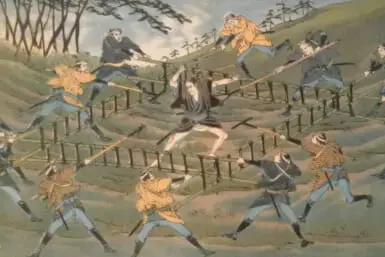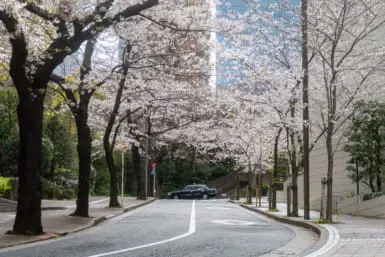
Photo by Seiha Yamaguchi
It was a warm summer day in June when I stepped inside Chim Pom’s grungy studio in Koenji in western Tokyo and was met with a warm welcome by three of their six members: Yasutaka Hayashi, the camera-man and design artist, Masataka Okada, the drawing artist, and Motomu Inaoka who is, according to Chim Pom’s only female member Ellie in a 2012 interview, a “great three-dimensional artist.” The studio is a two-floor organized mess structured by scaffolding and filled with art installations. It is comprised of several rooms built around an open atrium, where the three of them are sat around a small table, sipping canned coffees and chain-smoking cigarettes.
Chim Pom’s members first met in 2005, when they were all young art students: “Good contemporary artists and musicians taught there, and we attended. Everyone was pretty scattered, but we met there coincidentally and ended up going for drinks,” said Yasutaka. As Ryuta Ushiro, the collective’s leader, expressed in 2012, Ellie was always the core of the group: “Her personality, style, everything about her was artistic. She was art herself, and we thought about what we could create with her.”
During their early beginnings, the group wasn’t specifically set on making art, but rather on doing something interesting and exciting, using video as their main medium. Though anime and manga were popular artistic genres at the time, headed by household names such as Takashi Murakami and Yoshitomo Nara, Chim Pom was already going against the grain. Says Yasutaka: “At the time we thought – ‘We want to make something different, something that is different from the trends.'”

2006, courtesy of Chim Pom
Influenced by “Interesting Stuff”
It is no secret that the collective was influenced by Japanese contemporary artists such as Takashi Murakami and Aida Makoto and their fearlessness to dive into new and unpopular methods and subjects, and their provocativeness, but inspirational sources were varied. “What we believed in was Japanese culture: television, anime, manga and so on. We were influenced by that kind of interesting stuff, so not really by particular artists or people,” said Yasutaka.
He mentioned being inspired by MTV, for instance, which he considers to be a strong reflection of pop culture during the early 2000s. These influences and inspirations undoubtedly show in some of the collective’s early work, in which they used both provocative subjects such as sex and nudity and daring methods like flashy and incredibly personal performance art. Already, the group had set themselves apart by using humor and satire to shed light on sometimes dramatically serious or controversial topics.
In their project ‘Erikotel‘ (2007), for example, they published a series of ads in newspapers and magazines for an erotic hotline, only to convert the electromagnetic waves generated by the dozens of anonymous calls into electricity, using a machine they had built. This was a rather humorous way to point at some Japanese men’s extremely high libido, but also at the way we create energy. Also in 2007, in a project titled ‘Thank you Celeb’, the group took a month-long trip to Cambodia, during which they combined Ellie’s dream of helping a charitable cause by blowing up some of their personal belongings on local land mines, including what they consider “celebrity items,” such as luxury bags or a plaster figure of Ellie striking a pose. As a part of the project, they also helped child victims of landmine explosions and took part in local land mine removals. Upon their return to Japan, Chim Pom organized a charity auction during which they sold all of the burned, exploded items. The auction raised a total of 2.1 million yen.
Video credit: Chim Pom
The Social Rebels of Japan
Most of their works pre-2011 consisted of thought-provoking performance pieces, installations or visual exhibits tackling a variety of controversial issues, ranging from religion to pornography and self-exploration. The group was already met with some success, both in the form of exhibitions and publishing deals, and was being described as the neo-dadaist group and social rebels of Japan.
After the devastating 2011 earthquake and tsunami, however, “politics started moving,” as expressed by Hayashi, which led them to change their process – “It wasn’t that we wanted to do something socially motivated or change things, but because of what that time was like that we did the things we did.”
We had to visit the disaster zone and see what the situation was.
According to them, the group felt that they could only express and explore the aftermath of a disaster of this magnitude through art: “We’re artists and we had to take the plunge and express through art, but to arrive at that we had to visit the disaster zone and see what the situation was – and while we were doing that we thought we should do an exhibition. Whether it was OK to do this or not was our biggest worry.” This line of thinking, prompted by a general feeling that “all art was unnecessary, exhibitions, live shows, pleasure and amusement was all on hold,” ultimately led them to do the only thing they knew how: to keep creating.
In their series about the disaster entitled “Real Times,” as well as their initiative “Don’t Follow the Wind,” they visited the exclusion zone of Fukushima, and created a variety of works showcasing the aftermath of the event, including a VR project in which visitors could look at photos of the abandoned homes that victims had left behind. These projects brought on quite a bit of controversy and even some attention from the authorities, as it was illegal to penetrate the Fukushima no-go zone, but they were ultimately widely appreciated by both the public and the art community and shown all around the world.
Though the group insists that their work is not intended as political, it is certainly received as such by many. Through recurrent themes like capitalism, consumer culture, youth culture, the meaning of art, sexuality and nudity, taboo, mainstream media and war, and using a satirical and provocative approach, the group uses “the now” as their weapon. “Expressing ‘the now’ influences people a hundred years in the future,” said Hayashi.

“Red Card”, 2011, Chim Pom, courtesy of the artist, MUJIN-TO Production, Tokyo & ANOMALY
A Country at the Crossroads
The group is quite humble about their success – which has long reached the international community – and how much it has affected young people in Japan: “If that’s what you think, then as a body of work it has succeeded. We’re mostly good for nothings, but because of that we can shine a light, we can show that good for nothings can do something too.” This approach resonates with many young people in Japan – those who are tired of the perhaps stricter and more traditional aspects of society, and who wish for a more progressive political and social system.
Many seem to be touched by the questions Chim Pom raises, both within Japan and internationally – and not without good reason. At a time where the country is at a crossroads in social and political terms, works like those produced by the collective fascinate the art world and the general public.
Their most recent project took place in Manchester, England, where they ran a project called “A Drunk Pandemic.” Inspired by the cholera epidemic that devastated Manchester in 1830, the group, along with five local artists, set up a temporary underground brewery and organized events for the public to be able to participate. The collective has also recently taken part in some activism, by joining other artists of the Aichi Triennale in a statement about censorship and threats of violence made during the event.
Though it is impossible to predict the daring collective’s next move, we undoubtedly look forward to seeing how it further impacts both Japan and the international artistic community.









